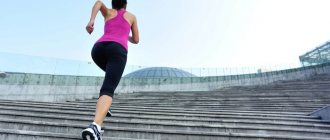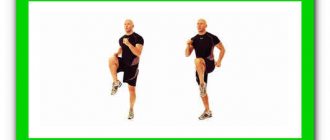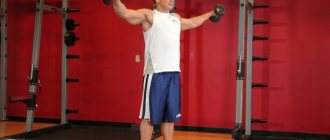Exercises for legs and buttocks on the stairs
Exercises for legs and buttocks on the stairs are available to everyone. Nothing is required except a ladder! And after 9 weeks, your legs are slimmer and your buttocks are firmer.
And your overall condition is the envy of everyone!
The program is designed for 9 weeks , but you can continue indefinitely!
The staircase is an ideal device for training: no need to spend money, we go up and down the stairs every day, no need to learn anything extra!
Fitness expert Ingo Froböse offers the perfect workout for anyone who dreams of toned legs and a firm butt.
Stairs train both the circulatory system and the large muscles of the body.
If you go up to the 6th floor every day (rather than using the elevator), then undoubtedly it trains both endurance and improves the functioning of the cardiovascular system.
Exercises for legs and buttocks on the stairs. For what?
- Stair training strengthens the heart;
- Stair training is a good exercise for the leg muscles and buttocks;
- By moving up and down, training on the stairs is formed almost independently, like training using the interval method: Up with effort, down with relaxation;
- If you increase the pace or step in 2 steps, the workout varies;
- You can climb the stairs on 1 leg! In this case, you must be extremely careful and attentive to avoid injury.
Week 1-2
- Climb the stairs initially three times at a pace and with active use of your arms.
- Escape freely and exhale consciously and long.
Week 2-4
- Climb the stairs three times, vigorously swinging your arms.
- Go downstairs calmly.
- After that, climb the stairs - 20 steps at a time.
- Pause 30 seconds. During the pause, swing your arms and rise on your heels, alternately rocking from your toes to your heels.
Repeat 3 times.
From 5th week
- Everything remains the same, just now rise, actively stepping on the foot.
- This resembles a slightly springy step - and the exercise is more tiring.
From 9th week
- Rise up, actively pressing your feet and almost without swinging your arms.
- Step only on every second step. This perfectly trains the muscles of the buttocks and thighs.
- After the third pass, stand with the right side of your body next to the first step and place your right foot on the step, leaving your left foot on the ground.
- Now sit down and “swing” from toe to heel for 15-20 seconds.
- Then shake your leg and repeat on the left side.
Watch the video: Exercises for legs and buttocks on the stairs
And such exercises are a direct path to success!
Exercises for legs and buttocks
1
Execution technique
To get started, check out these helpful tips.
- First of all, be sure to do a warm-up - warm up the muscles of your legs and back. Perform circular rotations of the working joints, jump in place, stretch well;
- Work out in comfortable sportswear, don’t skimp on high-quality sneakers with springy soles;
- Start the lesson at a slow pace, gradually increasing it towards the middle. The last 10% of the time, slow down smoothly. Finish the workout with a small stretching routine and breathing exercises;
- While walking, breathe regularly and take moderate deep breaths. Inhale through your nose, exhale through your mouth.
- The recommended heart rate zone is 130-140 beats. /min. You can download a special fitness application to your phone or buy a fitness watch;
- For those who want to take the stairs to lose weight, for quick results, reviews recommend doing it at the fastest pace you are capable of.
- Take breaks only after going down: you go up, immediately go down - you can sit for a while.
Exercise “Staircase” | Bodybuilding and Fitness
The “Staircase” exercise has a simple technique of execution, but at the same time it has many excellent properties and promotes high-quality training of the leg muscles. The exercise can be performed at home, on the landing.
Exercise “Staircase” is included in the sections
- Foot exercises
- Lower leg exercises
- Quadriceps exercises
- Exercises for hamstrings
- Exercises for the buttocks
- Warm-up exercises
- Endurance exercises
- Exercises to train your heart
- Exercises for weight loss
- Exercises for health
This exercise is perfect for warming up the body before the main part of the workout. It can also be used as a main exercise to work out the muscles of the lower body, train the heart, endurance, improve health, and also lose excess weight.
You need to perform the exercise on the stairs, simply climbing up them. The ladder can be replaced with blocks, but this is less convenient and not as effective, since you have to go up and down immediately. But you can train on blocks within the gym. A stepper can serve as an excellent replacement for stairs; This is a cardio machine that works on a similar principle to climbing stairs.
There are two options for performing the exercise
- The classic version - a step is performed on each step.
- An additional option is to perform the step in several steps.
Exercise “Staircase” one step at a time (classic version)
General
This is a fast version of the exercise. The main load falls on the quadriceps and lower leg, although the muscles are not worked out as significantly, since the amplitude of movement is small. Due to the fast pace of execution, you have the opportunity to train your endurance and heart muscle well. The classic version is perfect for warming up.
Working muscles
The main work is performed by the quadriceps, and a little by the calf muscles. Also, a small proportion of the load falls on the stabilizer muscles of the whole body.
Initial position
Stand near a ladder, blocks, or on a stepper. Bend your arms slightly and keep them in a loose position near your body. The gaze is directed down the steps.
Execution technique
Climb up the stairs, taking one step at a time. You need to step through the front of the foot, and not through the whole. The movement occurs mainly due to flexion and extension of the knee joint and slightly due to the ankle joint. Perform the exercise at a fast or medium pace.
If there is nowhere to go further up the stairs, then go down and repeat the exercise again. When practicing on blocks, you will have to take a step or a couple of steps, and then go down in a reverse motion, without turning your whole body back. When training on a stepper, you will not have any problems with going down, since the mechanism of the simulator provides for an endless ascent up the steps.
Additional equipment (nuances)
This exercise has no technical subtleties or nuances.
Technical errors
Keep your eyes on the steps, otherwise you may trip. Step across the forefoot to minimize stress on all joints during the movement.
Load Accent
In this exercise, you can shift the load from the quadriceps to the calf muscles. To do this, while climbing stairs, more actively extend and bend the ankle joint, pushing off mainly with your toe. The knees bend only slightly, helping in movement. The pace is even faster than with the standard technique.
Exercise “Staircase” step through several steps (additional option)
General
This is a strength version of the exercise, aimed more at training the leg muscles. Stepping up a few steps puts you in a deep squat or lunge position, so more muscle groups are affected and the load itself increases. This variation is not suitable for training the heart or endurance. Also, the exercise is not suitable as a warm-up.
Technique and features
Each foot step you take is one or several steps, depending on the length of your legs and the size of the steps. The exercise can also be performed on high blocks. But you won’t be able to repeat the exercise on a stepper, since the design of the simulator itself is designed for a step on each step.
Do not lean your body forward too much, because the work should be done by the muscles of the legs, and not by moving the body weight forward. The pace of execution is slow. In this version of the exercise, step through your full foot. Your arms are bent at the elbows as much as possible and located near your chest - this will allow you to better concentrate on performing the exercise, and besides, the temptation to rest your hands on your hips or knees while lifting will disappear.
Application
An additional version of the exercise involves many other muscle groups: quadriceps, hamstrings, buttocks. This is the main advantage that makes it worth choosing this particular variation.
Additional Information
How long to do the exercise
On average, the exercise should be performed from 1 to 15 minutes. During the performance, you can take short breaks to rest the muscles and restore breathing and pulse; pause no more than 60-90 seconds.
Using weights
If you have a high level of fitness or you need to make the exercise as strong as possible, then you have the right to add additional weights. Take a load in your hands, for example, in the form of a dumbbell, and start performing the “Staircase” exercise in the classic or additional version. In this case, the arms should hang down freely.
Weight loss
The “Staircase” exercise, especially in the classic version, where the pace of execution is fast, is good for burning calories - but this is only on one side. In fact, it is unlikely that you will be able to use this exercise specifically for weight loss, since it is quite heavy in its load. To effectively lose weight, you need to perform the exercise without rest for 15 minutes or more, but even many trained athletes will not be able to walk up the stairs for that long. So, while climbing stairs, you do burn a lot of calories, but you should not take this exercise as the main one for losing weight.
Let's sum it up
General
Exercise "Staircase". Brief information about this exercise:
- The exercise can be performed either in steps of each step or in steps of several steps.
- The exercise is performed on stairs, blocks or a stepper.
- In the classic version of the exercise, the quadriceps and calf muscles work. In an additional version, the quadriceps, calf muscles, hamstrings, and buttocks work.
Perform anytime, anywhere
The main feature of the exercise is that it can be performed anywhere there is a ladder. This way, you can always give yourself a short full-body workout to keep your muscles toned, improve your health, and improve your endurance.
How to walk correctly?
- The heart rate during training should always be within 60%-80% of the maximum heart rate, which is calculated by the formula: 220 minus the number of years.
- It is necessary to walk at such a pace that breathing is frequent, but the ability to speak is preserved.
- You need to walk continuously, without stopping for rest or breaks in order to restore your breathing.
- A fitness workout involving walking on steps should be preceded by a warm-up for the joints, and the session should be completed with stretching exercises.
- Increasing the upward speed is always welcome and gives good results. But descending at a fast pace is dangerous, because in this position the load increases not on the muscles, but on the joints .
Exercise Ladder: types and benefits
Learn how to increase strength, build muscle, and burn excess body fat with a simple workout routine.
Many guys played the sports game Ladder in childhood; it is usually used in pull-ups on the horizontal bar, push-ups on parallel bars and from the floor.
However, you rarely see it performed in gyms, although it would be useful to introduce it into the workout for variety in order to avoid a monotonous exercise schedule.
LADDER is an exercise performed with your own body weight or with the same weight by 2 or more people. The sets are performed immediately after the last person has completed the exercise.
Types of stairs
1. STRAIGHT LADDER - when the number of repetitions increases, for example, performed 1 repetition, then 2, 3 and so on.
2. REVERSE LADDER - starts with the highest number of repetitions, for example, 10, 9, 8 and so on until only 1 repetition is completed.
3. ONE-WAY - when all repetitions go in only one direction, either ascending or descending.
4. TWO-WAY - when repetitions go in ascending order to a certain number, and then in descending order, or vice versa.
I just want to note, don’t think that the ladder and the pyramid principle are the same thing, in the pyramid the working weight changes in each approach of the exercise, but in the ladder it does not change.
The benefits of ladders
1. GROWTH IN STRENGTH
This is achieved thanks to short ladders, for example, you do 110 kg in the bench press for 1 repetition, take the weight 85% of the maximum (93.5 kg) and perform a double-sided pass - 1-2-3-4-3-2- 1 reps for a total of 16 reps of your maximum weight.
For a double effect of increasing strength + mass, you need to take a weight of 75% of the maximum (82.5 kg) and do the same, but with a different number of repetitions - 1-2-3-4-5-6-5-4-3- 2-1, this will total 36 reps.
2. GROWTH IN STRENGTH ENDURANCE
Try to complete the entire length of the ladder as quickly as possible in ascending or descending repetitions with a minimum amount of rest; this scheme will increase the strength endurance of the muscles.
3.INCREASE THE EFFICIENCY OF EXERCISE BY 20%
According to data based on scientific experiments, when performing ladder exercises in pairs, the competition mechanism is activated, this allows you to perform an extra set of exercises or more repetitions, thus putting more stress on the muscle fibers, which increases the effectiveness of the entire workout by at least 20%.
4. INCREASE THE INTENSITY OF YOUR TRAINING
Constantly performing exercises one after another allows for minimal rest; this is useful for training the cardiovascular system, helps in gaining muscle mass and promotes increased burning of excess calories.
5. BURN FAT
If your goal is to burn fat deposits, then use long ladders up to 10 repetitions, take the weight 60-70% of the maximum, but you need to choose basic exercises, where more muscles are involved in the work and calories are burned 2 times faster.
CONCLUSION
— the ladder can be performed anywhere, even without the use of special exercise equipment, this is a great way to keep yourself in shape during a business trip, outdoor recreation and at home
- do not forget that for the ladder you need at least 2 people, ideally 3-4, and the forces should be approximately equal, otherwise the competition will not be equal
— when performing pull-ups or push-ups on parallel bars, you can hang a decent weight on your belt and perform a short ladder, the main thing is that the weight is the same from start to finish
- the ladder exercise will allow the muscles not to get used to the load, the body will receive additional stress and come out of a state of stagnation, which will immediately affect the growth of strength, mass and will entail burning an increased amount of calories.
We recommend you:
Duration of training
Climbing stairs is good because it allows you to choose the time and load regimen individually. This is influenced by various factors:
- age;
- health status;
- presence of chronic diseases;
- initial physical training;
- total body weight;
- availability of free time.
The general recommendation for everyone is regularity. The load must be introduced gradually, without overtaxing the body. It is recommended to start with 5 minutes, gradually increasing to 20. At the beginning, take a short section of the path, it will be enough to go through two or three openings in both directions, gradually the route should be increased.
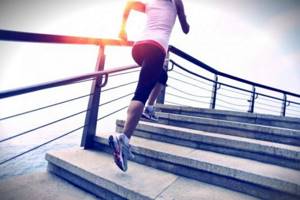
Effective weight loss with exercises on the stairs
Walking and running on stairs are effective means for losing weight, burning a lot of calories and gaining body contour. However, in addition to such aerobic exercise on the stairs, you can also perform a variety of exercises for most muscle groups, which will make the workout even more useful and effective.
General rules for losing weight and creating relief
Effective weight loss is not just about regular, grueling workouts in the gym. To combat excess weight, you need, first of all, to make adjustments to your usual lifestyle, because often excessive body weight is a consequence of an incorrect approach to nutrition and physical activity.
In order to get rid of excess fat deposits and make your body fit, it is important to adhere to the following recommendations:
- Follow a proper diet, in which there should be at least four meals a day at approximately equal intervals. To avoid overeating, usual portions should be reduced by at least a third.
- Make your diet healthy and balanced, in which proteins come first, then fats and only then carbohydrates. Your diet should be based on vegetables and fruits, cereals and dairy products, lean meat and legumes.
- Make fitness an integral part of your life. Comprehensive training consisting of aerobic and strength exercises is best suited for combating excess weight and gaining relief.
- Switch to an active lifestyle. Use the elevator and transport less, walk more, and if you have a sedentary job, take regular short breaks to warm up.
Fitness program for training on stairs
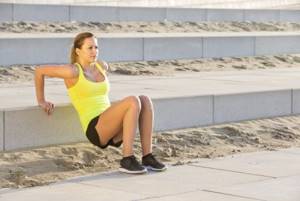
Losing weight with the right approach can be achieved through almost any physical activity; the difference is only in the speed of the process and the number of kilograms lost. Aerobic training is rightfully considered the best for burning fat - it accelerates metabolism and evenly removes extra centimeters. Strength training is necessary to strengthen the muscle corset and achieve beautiful relief. Therefore, the ideal option is to combine these two types of load.
Due to the fact that some of the most problematic areas of the female body are the hips and buttocks, the stair workout suggested below is an excellent option for working them out and developing the whole body as a whole. Simply walking up the stairs already strengthens all the muscles of the legs, long steps over several steps provide greater muscle contraction and develop endurance, and short steps make the muscles work more intensely and help activate the fat burning process. In addition, you can perform other equally effective exercises on the stairs that will help work out other problem areas.
For this fitness workout you will need a staircase with 10 steps, each of which should be equal in width to your foot. It would be good if the stairs had railings and carpeting, which would make the training safer and somewhat easier.
A sample lesson plan looks like this:
- The first three minutes should be devoted to warming up and warming up by running up and down the stairs at a comfortable pace.
- For the next three minutes, you need to perform the first four exercises. Each of them must be done 10 times, and then this cycle must be repeated in a circle until the time for this stage runs out.
- Next, for three minutes you need to run up the stairs at a normal pace, from time to time changing it to a wider step every other step. It is advisable to move at a fast pace, to maintain which you can help yourself with your hands.
- Rest for one minute.
- For the next three minutes, perform the other four exercises 10 times each. Do as many circles as you can in three minutes.
- Repeat the three-minute sprint again, alternating between regular and wide strides.
- Take one minute to rest.
- Repeat steps 2-6 already done at the same pace.
- In the last two minutes, change to a calm pace and walk up and down the stairs.
This kind of fitness will allow you to burn extra pounds in a short time, tone your whole body well and beautifully draw muscle definition.
Exercises on the stairs

Exercises for different muscle groups performed on the stairs:
- Stand with both feet on the second step. Lift one leg, move it back and bend it so that the knees of both legs are closed. Jump on one foot onto the bottom step and immediately jump back onto the second. If you need support for this exercise, you can use a railing as it.
- Stand with your back to the stairs, place both feet on one of the first steps and take a pose in support, lying on straight arms. Lift one straight leg off the floor and do a push-up, then lift the other leg and do another push-up.
- Stand in front of the stairs and lunge forward, placing your foot on the second step. Then push off with that leg and jump up, lifting the knee of your other leg high. Place both feet back in place and squat down into a lunge again.
- Sit on the top step and place your feet on the step below. Raise your legs straight above the stairs, place your hands on the back of your head. Bend your closed legs and pull them as close to your chest as possible. In this exercise, it is important to monitor the position of your back - you do not need to round your lower back.
- Sit on the second step from the bottom, lean your hands on the next step on either side of you, straighten your legs and rest them on the floor. Straighten your arms and lift your hips up at the same time, then bend your arms, bringing your elbows back and lowering your pelvis as low as possible, but do not sit on the step.
- Place yourself on the third step from the bottom on your side so that your lower leg is bent at the knee and rests completely on the step. Place your hands on the step above, straighten your upper leg and slowly lift your body up.
- Get into plank pose, leaning on the bottom step. Move your hands one by one to the second step, and then return to the first.
- Stand near the stairs, lunge with one leg, step onto the third step and squat, then place the other leg on it. Next, squat into a lunge, placing your foot on a higher step, and thus get to the top of the stairs. It is recommended to perform this exercise at a fast pace.
How many calories are burned?
All women who are losing weight are interested in how many calories are burned when walking up the stairs. By the way, this exercise takes much more energy than regular jogging, because during the lifting process the athlete is forced to constantly overcome the force of gravity.
- On average, a person spends 1 kcal for every 10 steps;
- Thus, at a moderate pace, he will burn 10-15 kcal per minute;
- Using simple calculations, we calculate that you can lose 600-900 kcal in an hour
Energy expenditure depends on many factors, such as the weight of the athlete. The more a person weighs, the more difficult it is for him to carry his kilograms up the stairs, and accordingly, the more calories he will spend. Also influenced by the speed of movement, the duration of the activity, and even the air temperature in the area.
As you can see, walking up the stairs is effective for losing weight - calories are burned more actively than when running (500-600 kcal per hour). By the way, when the initial load becomes familiar to you, try to speed up the pace or switch from walking up the stairs to running. Or, start using weights. This will increase the difficulty of the task, which means you will burn many more calories. If you are trying to lose weight, remember to eat healthy, get enough sleep and rest.

